UTI and Altered Mental Status in Older Adults: An Analysis
VerifiedAdded on 2020/03/23
|6
|2100
|48
Essay
AI Summary
This paper investigates the accuracy of the statement that urinary tract infections (UTIs) in older adults can lead to alterations in mental status, such as confusion and challenging behaviors, and the implications for patient safety and nursing care. It explores the pathophysiology and symptomology of UTIs in the elderly, highlighting how these infections can manifest differently in older individuals, often presenting with behavioral changes rather than classic physical symptoms. The essay discusses the relationship between UTIs and confusion, emphasizing that confusion can be a primary indicator of infection in this population. It also examines the implications for patient safety and the importance of effective communication between nurses and patients, advocating for a patient-centered approach to care. The conclusion affirms the accuracy of the initial statement, underscoring the need for healthcare providers to be vigilant in recognizing and addressing UTIs in older adults to ensure optimal patient outcomes.
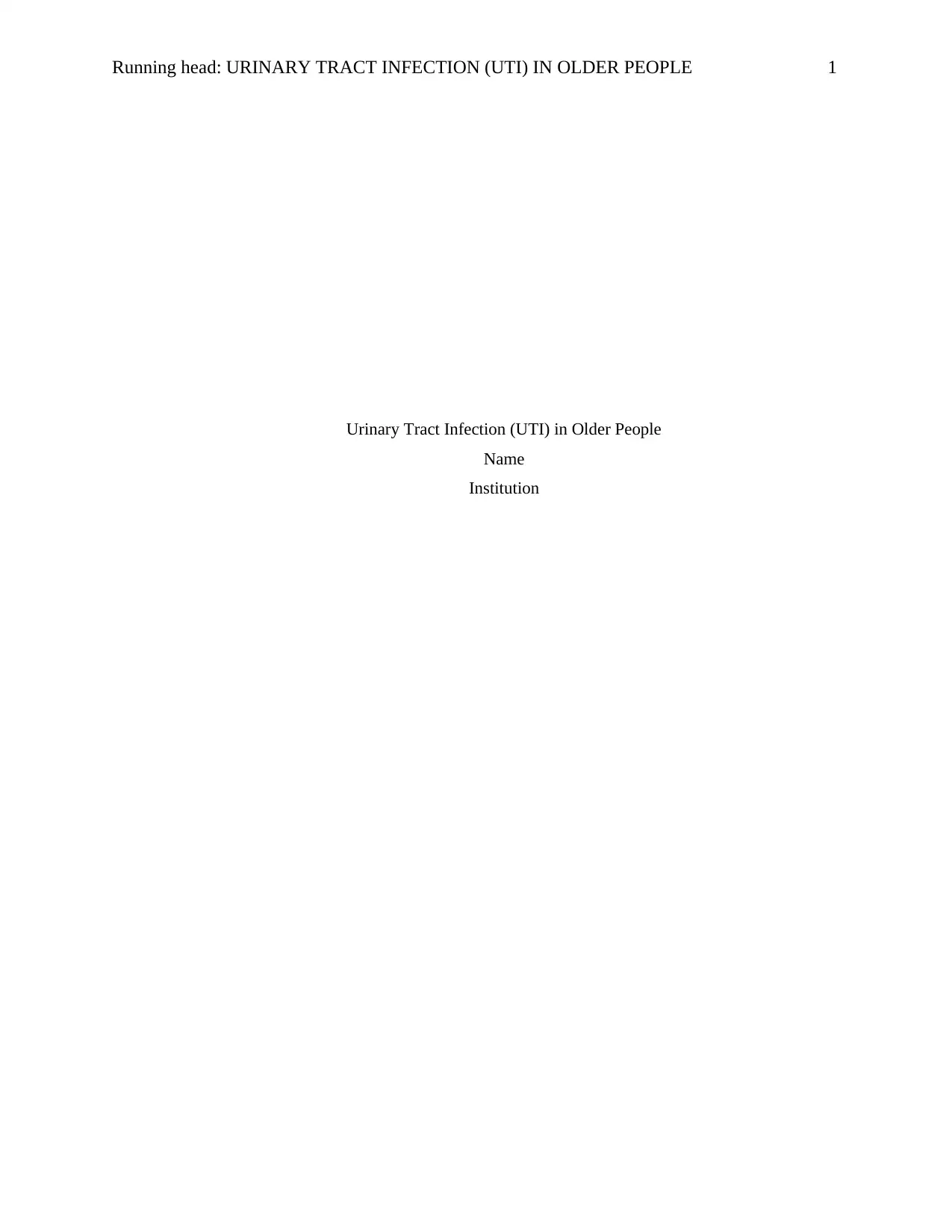
Running head: URINARY TRACT INFECTION (UTI) IN OLDER PEOPLE 1
Urinary Tract Infection (UTI) in Older People
Name
Institution
Urinary Tract Infection (UTI) in Older People
Name
Institution
Paraphrase This Document
Need a fresh take? Get an instant paraphrase of this document with our AI Paraphraser
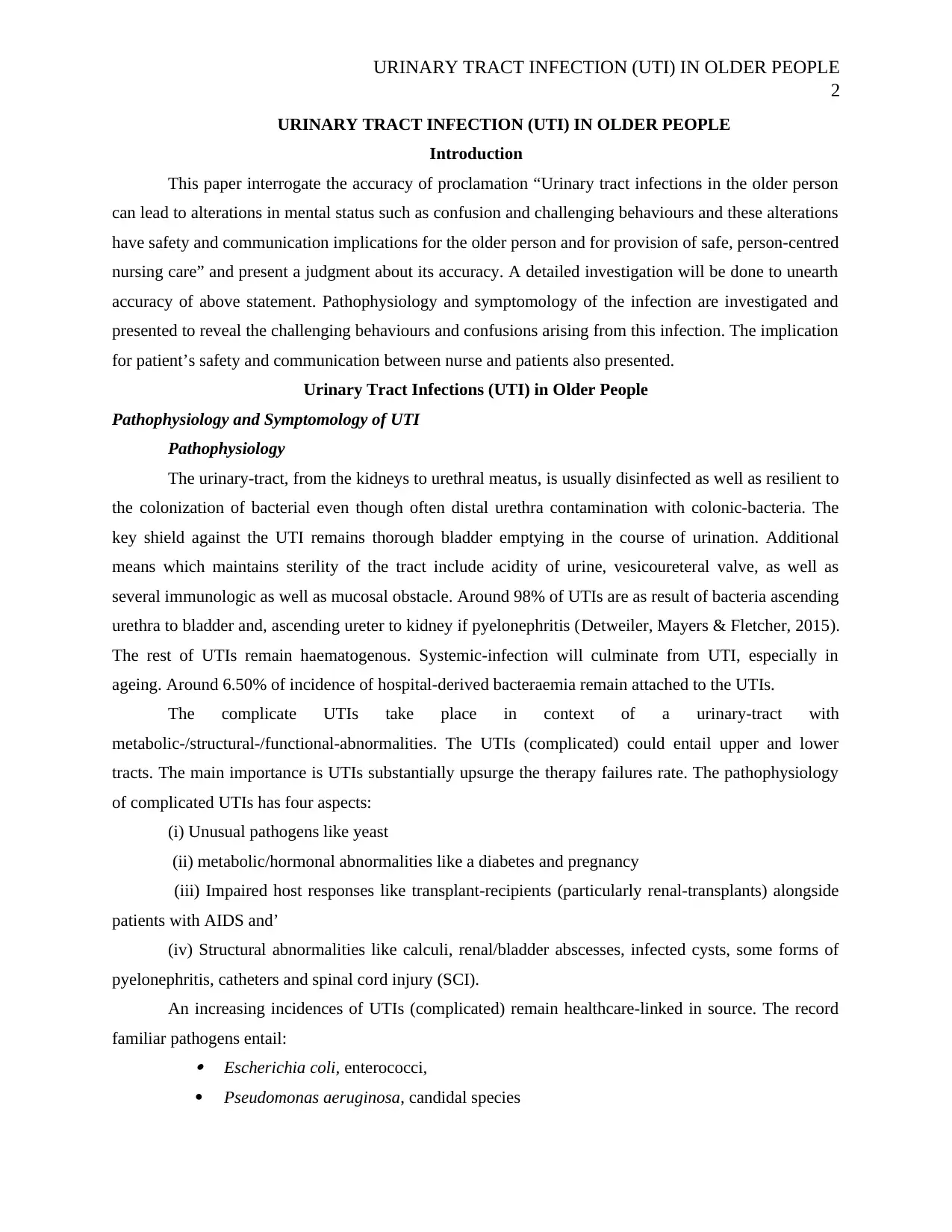
URINARY TRACT INFECTION (UTI) IN OLDER PEOPLE
2
URINARY TRACT INFECTION (UTI) IN OLDER PEOPLE
Introduction
This paper interrogate the accuracy of proclamation “Urinary tract infections in the older person
can lead to alterations in mental status such as confusion and challenging behaviours and these alterations
have safety and communication implications for the older person and for provision of safe, person-centred
nursing care” and present a judgment about its accuracy. A detailed investigation will be done to unearth
accuracy of above statement. Pathophysiology and symptomology of the infection are investigated and
presented to reveal the challenging behaviours and confusions arising from this infection. The implication
for patient’s safety and communication between nurse and patients also presented.
Urinary Tract Infections (UTI) in Older People
Pathophysiology and Symptomology of UTI
Pathophysiology
The urinary-tract, from the kidneys to urethral meatus, is usually disinfected as well as resilient to
the colonization of bacterial even though often distal urethra contamination with colonic-bacteria. The
key shield against the UTI remains thorough bladder emptying in the course of urination. Additional
means which maintains sterility of the tract include acidity of urine, vesicoureteral valve, as well as
several immunologic as well as mucosal obstacle. Around 98% of UTIs are as result of bacteria ascending
urethra to bladder and, ascending ureter to kidney if pyelonephritis (Detweiler, Mayers & Fletcher, 2015).
The rest of UTIs remain haematogenous. Systemic-infection will culminate from UTI, especially in
ageing. Around 6.50% of incidence of hospital-derived bacteraemia remain attached to the UTIs.
The complicate UTIs take place in context of a urinary-tract with
metabolic-/structural-/functional-abnormalities. The UTIs (complicated) could entail upper and lower
tracts. The main importance is UTIs substantially upsurge the therapy failures rate. The pathophysiology
of complicated UTIs has four aspects:
(i) Unusual pathogens like yeast
(ii) metabolic/hormonal abnormalities like a diabetes and pregnancy
(iii) Impaired host responses like transplant-recipients (particularly renal-transplants) alongside
patients with AIDS and’
(iv) Structural abnormalities like calculi, renal/bladder abscesses, infected cysts, some forms of
pyelonephritis, catheters and spinal cord injury (SCI).
An increasing incidences of UTIs (complicated) remain healthcare-linked in source. The record
familiar pathogens entail:
Escherichia coli, enterococci,
Pseudomonas aeruginosa, candidal species
2
URINARY TRACT INFECTION (UTI) IN OLDER PEOPLE
Introduction
This paper interrogate the accuracy of proclamation “Urinary tract infections in the older person
can lead to alterations in mental status such as confusion and challenging behaviours and these alterations
have safety and communication implications for the older person and for provision of safe, person-centred
nursing care” and present a judgment about its accuracy. A detailed investigation will be done to unearth
accuracy of above statement. Pathophysiology and symptomology of the infection are investigated and
presented to reveal the challenging behaviours and confusions arising from this infection. The implication
for patient’s safety and communication between nurse and patients also presented.
Urinary Tract Infections (UTI) in Older People
Pathophysiology and Symptomology of UTI
Pathophysiology
The urinary-tract, from the kidneys to urethral meatus, is usually disinfected as well as resilient to
the colonization of bacterial even though often distal urethra contamination with colonic-bacteria. The
key shield against the UTI remains thorough bladder emptying in the course of urination. Additional
means which maintains sterility of the tract include acidity of urine, vesicoureteral valve, as well as
several immunologic as well as mucosal obstacle. Around 98% of UTIs are as result of bacteria ascending
urethra to bladder and, ascending ureter to kidney if pyelonephritis (Detweiler, Mayers & Fletcher, 2015).
The rest of UTIs remain haematogenous. Systemic-infection will culminate from UTI, especially in
ageing. Around 6.50% of incidence of hospital-derived bacteraemia remain attached to the UTIs.
The complicate UTIs take place in context of a urinary-tract with
metabolic-/structural-/functional-abnormalities. The UTIs (complicated) could entail upper and lower
tracts. The main importance is UTIs substantially upsurge the therapy failures rate. The pathophysiology
of complicated UTIs has four aspects:
(i) Unusual pathogens like yeast
(ii) metabolic/hormonal abnormalities like a diabetes and pregnancy
(iii) Impaired host responses like transplant-recipients (particularly renal-transplants) alongside
patients with AIDS and’
(iv) Structural abnormalities like calculi, renal/bladder abscesses, infected cysts, some forms of
pyelonephritis, catheters and spinal cord injury (SCI).
An increasing incidences of UTIs (complicated) remain healthcare-linked in source. The record
familiar pathogens entail:
Escherichia coli, enterococci,
Pseudomonas aeruginosa, candidal species
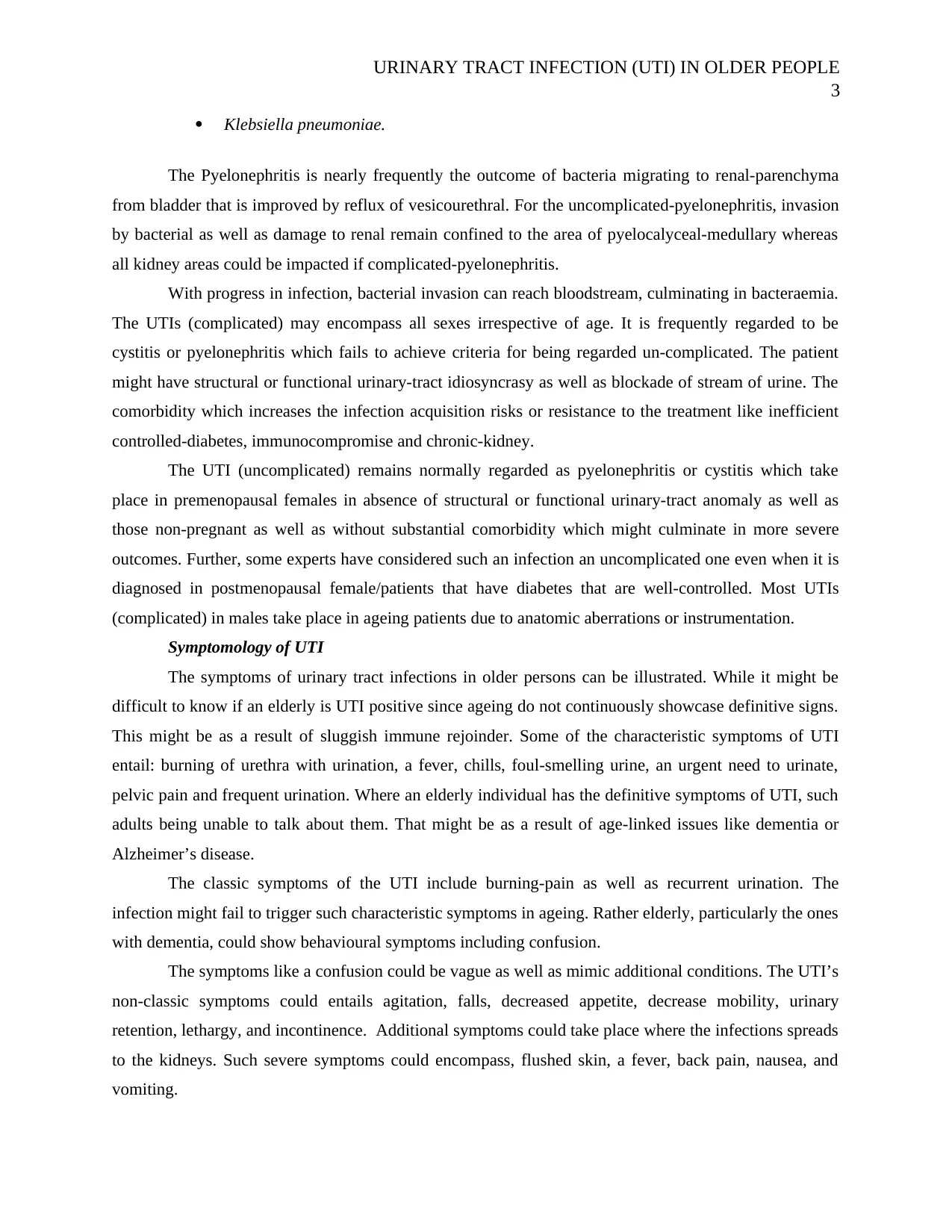
URINARY TRACT INFECTION (UTI) IN OLDER PEOPLE
3
Klebsiella pneumoniae.
The Pyelonephritis is nearly frequently the outcome of bacteria migrating to renal-parenchyma
from bladder that is improved by reflux of vesicourethral. For the uncomplicated-pyelonephritis, invasion
by bacterial as well as damage to renal remain confined to the area of pyelocalyceal-medullary whereas
all kidney areas could be impacted if complicated-pyelonephritis.
With progress in infection, bacterial invasion can reach bloodstream, culminating in bacteraemia.
The UTIs (complicated) may encompass all sexes irrespective of age. It is frequently regarded to be
cystitis or pyelonephritis which fails to achieve criteria for being regarded un-complicated. The patient
might have structural or functional urinary-tract idiosyncrasy as well as blockade of stream of urine. The
comorbidity which increases the infection acquisition risks or resistance to the treatment like inefficient
controlled-diabetes, immunocompromise and chronic-kidney.
The UTI (uncomplicated) remains normally regarded as pyelonephritis or cystitis which take
place in premenopausal females in absence of structural or functional urinary-tract anomaly as well as
those non-pregnant as well as without substantial comorbidity which might culminate in more severe
outcomes. Further, some experts have considered such an infection an uncomplicated one even when it is
diagnosed in postmenopausal female/patients that have diabetes that are well-controlled. Most UTIs
(complicated) in males take place in ageing patients due to anatomic aberrations or instrumentation.
Symptomology of UTI
The symptoms of urinary tract infections in older persons can be illustrated. While it might be
difficult to know if an elderly is UTI positive since ageing do not continuously showcase definitive signs.
This might be as a result of sluggish immune rejoinder. Some of the characteristic symptoms of UTI
entail: burning of urethra with urination, a fever, chills, foul-smelling urine, an urgent need to urinate,
pelvic pain and frequent urination. Where an elderly individual has the definitive symptoms of UTI, such
adults being unable to talk about them. That might be as a result of age-linked issues like dementia or
Alzheimer’s disease.
The classic symptoms of the UTI include burning-pain as well as recurrent urination. The
infection might fail to trigger such characteristic symptoms in ageing. Rather elderly, particularly the ones
with dementia, could show behavioural symptoms including confusion.
The symptoms like a confusion could be vague as well as mimic additional conditions. The UTI’s
non-classic symptoms could entails agitation, falls, decreased appetite, decrease mobility, urinary
retention, lethargy, and incontinence. Additional symptoms could take place where the infections spreads
to the kidneys. Such severe symptoms could encompass, flushed skin, a fever, back pain, nausea, and
vomiting.
3
Klebsiella pneumoniae.
The Pyelonephritis is nearly frequently the outcome of bacteria migrating to renal-parenchyma
from bladder that is improved by reflux of vesicourethral. For the uncomplicated-pyelonephritis, invasion
by bacterial as well as damage to renal remain confined to the area of pyelocalyceal-medullary whereas
all kidney areas could be impacted if complicated-pyelonephritis.
With progress in infection, bacterial invasion can reach bloodstream, culminating in bacteraemia.
The UTIs (complicated) may encompass all sexes irrespective of age. It is frequently regarded to be
cystitis or pyelonephritis which fails to achieve criteria for being regarded un-complicated. The patient
might have structural or functional urinary-tract idiosyncrasy as well as blockade of stream of urine. The
comorbidity which increases the infection acquisition risks or resistance to the treatment like inefficient
controlled-diabetes, immunocompromise and chronic-kidney.
The UTI (uncomplicated) remains normally regarded as pyelonephritis or cystitis which take
place in premenopausal females in absence of structural or functional urinary-tract anomaly as well as
those non-pregnant as well as without substantial comorbidity which might culminate in more severe
outcomes. Further, some experts have considered such an infection an uncomplicated one even when it is
diagnosed in postmenopausal female/patients that have diabetes that are well-controlled. Most UTIs
(complicated) in males take place in ageing patients due to anatomic aberrations or instrumentation.
Symptomology of UTI
The symptoms of urinary tract infections in older persons can be illustrated. While it might be
difficult to know if an elderly is UTI positive since ageing do not continuously showcase definitive signs.
This might be as a result of sluggish immune rejoinder. Some of the characteristic symptoms of UTI
entail: burning of urethra with urination, a fever, chills, foul-smelling urine, an urgent need to urinate,
pelvic pain and frequent urination. Where an elderly individual has the definitive symptoms of UTI, such
adults being unable to talk about them. That might be as a result of age-linked issues like dementia or
Alzheimer’s disease.
The classic symptoms of the UTI include burning-pain as well as recurrent urination. The
infection might fail to trigger such characteristic symptoms in ageing. Rather elderly, particularly the ones
with dementia, could show behavioural symptoms including confusion.
The symptoms like a confusion could be vague as well as mimic additional conditions. The UTI’s
non-classic symptoms could entails agitation, falls, decreased appetite, decrease mobility, urinary
retention, lethargy, and incontinence. Additional symptoms could take place where the infections spreads
to the kidneys. Such severe symptoms could encompass, flushed skin, a fever, back pain, nausea, and
vomiting.
⊘ This is a preview!⊘
Do you want full access?
Subscribe today to unlock all pages.

Trusted by 1+ million students worldwide
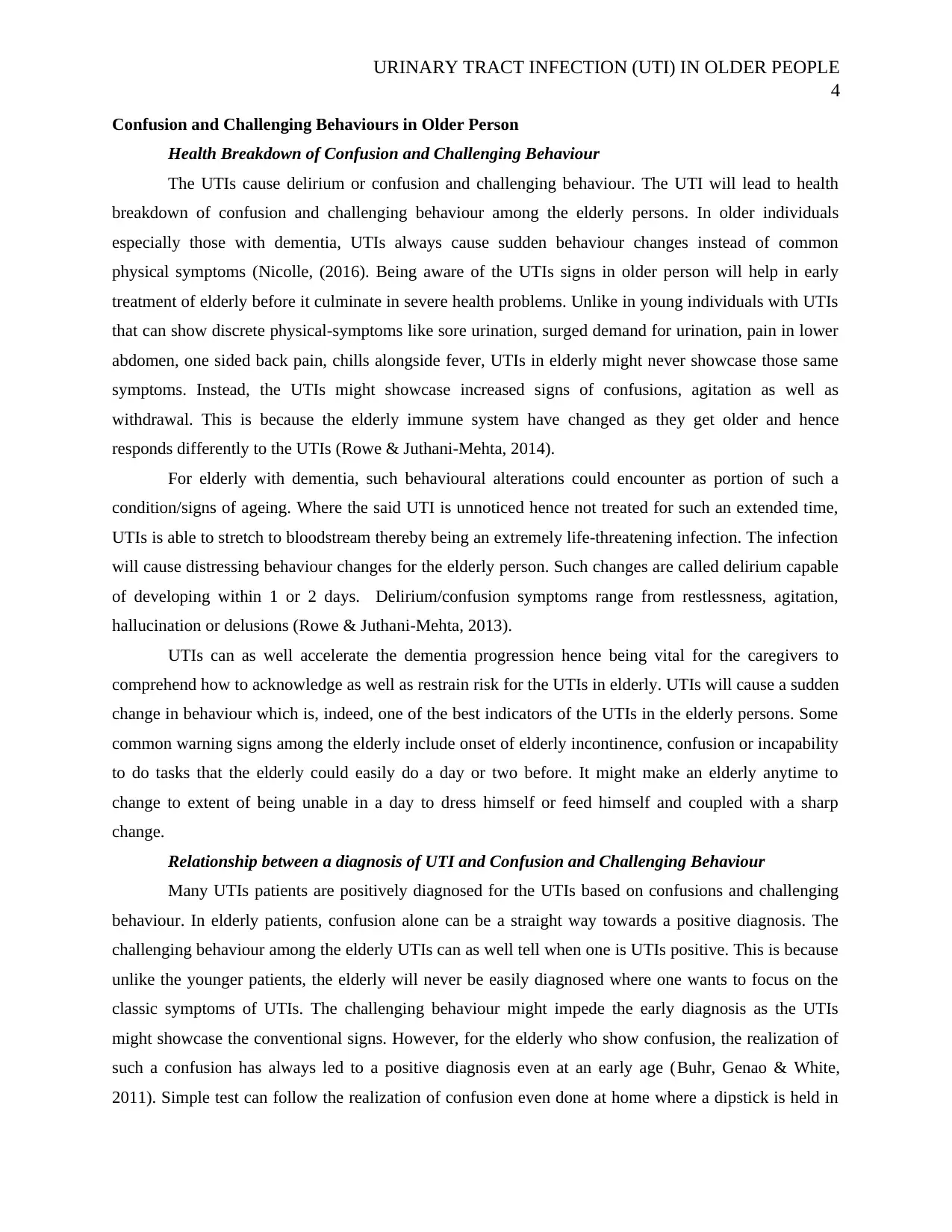
URINARY TRACT INFECTION (UTI) IN OLDER PEOPLE
4
Confusion and Challenging Behaviours in Older Person
Health Breakdown of Confusion and Challenging Behaviour
The UTIs cause delirium or confusion and challenging behaviour. The UTI will lead to health
breakdown of confusion and challenging behaviour among the elderly persons. In older individuals
especially those with dementia, UTIs always cause sudden behaviour changes instead of common
physical symptoms (Nicolle, (2016). Being aware of the UTIs signs in older person will help in early
treatment of elderly before it culminate in severe health problems. Unlike in young individuals with UTIs
that can show discrete physical-symptoms like sore urination, surged demand for urination, pain in lower
abdomen, one sided back pain, chills alongside fever, UTIs in elderly might never showcase those same
symptoms. Instead, the UTIs might showcase increased signs of confusions, agitation as well as
withdrawal. This is because the elderly immune system have changed as they get older and hence
responds differently to the UTIs (Rowe & Juthani-Mehta, 2014).
For elderly with dementia, such behavioural alterations could encounter as portion of such a
condition/signs of ageing. Where the said UTI is unnoticed hence not treated for such an extended time,
UTIs is able to stretch to bloodstream thereby being an extremely life-threatening infection. The infection
will cause distressing behaviour changes for the elderly person. Such changes are called delirium capable
of developing within 1 or 2 days. Delirium/confusion symptoms range from restlessness, agitation,
hallucination or delusions (Rowe & Juthani-Mehta, 2013).
UTIs can as well accelerate the dementia progression hence being vital for the caregivers to
comprehend how to acknowledge as well as restrain risk for the UTIs in elderly. UTIs will cause a sudden
change in behaviour which is, indeed, one of the best indicators of the UTIs in the elderly persons. Some
common warning signs among the elderly include onset of elderly incontinence, confusion or incapability
to do tasks that the elderly could easily do a day or two before. It might make an elderly anytime to
change to extent of being unable in a day to dress himself or feed himself and coupled with a sharp
change.
Relationship between a diagnosis of UTI and Confusion and Challenging Behaviour
Many UTIs patients are positively diagnosed for the UTIs based on confusions and challenging
behaviour. In elderly patients, confusion alone can be a straight way towards a positive diagnosis. The
challenging behaviour among the elderly UTIs can as well tell when one is UTIs positive. This is because
unlike the younger patients, the elderly will never be easily diagnosed where one wants to focus on the
classic symptoms of UTIs. The challenging behaviour might impede the early diagnosis as the UTIs
might showcase the conventional signs. However, for the elderly who show confusion, the realization of
such a confusion has always led to a positive diagnosis even at an early age (Buhr, Genao & White,
2011). Simple test can follow the realization of confusion even done at home where a dipstick is held in
4
Confusion and Challenging Behaviours in Older Person
Health Breakdown of Confusion and Challenging Behaviour
The UTIs cause delirium or confusion and challenging behaviour. The UTI will lead to health
breakdown of confusion and challenging behaviour among the elderly persons. In older individuals
especially those with dementia, UTIs always cause sudden behaviour changes instead of common
physical symptoms (Nicolle, (2016). Being aware of the UTIs signs in older person will help in early
treatment of elderly before it culminate in severe health problems. Unlike in young individuals with UTIs
that can show discrete physical-symptoms like sore urination, surged demand for urination, pain in lower
abdomen, one sided back pain, chills alongside fever, UTIs in elderly might never showcase those same
symptoms. Instead, the UTIs might showcase increased signs of confusions, agitation as well as
withdrawal. This is because the elderly immune system have changed as they get older and hence
responds differently to the UTIs (Rowe & Juthani-Mehta, 2014).
For elderly with dementia, such behavioural alterations could encounter as portion of such a
condition/signs of ageing. Where the said UTI is unnoticed hence not treated for such an extended time,
UTIs is able to stretch to bloodstream thereby being an extremely life-threatening infection. The infection
will cause distressing behaviour changes for the elderly person. Such changes are called delirium capable
of developing within 1 or 2 days. Delirium/confusion symptoms range from restlessness, agitation,
hallucination or delusions (Rowe & Juthani-Mehta, 2013).
UTIs can as well accelerate the dementia progression hence being vital for the caregivers to
comprehend how to acknowledge as well as restrain risk for the UTIs in elderly. UTIs will cause a sudden
change in behaviour which is, indeed, one of the best indicators of the UTIs in the elderly persons. Some
common warning signs among the elderly include onset of elderly incontinence, confusion or incapability
to do tasks that the elderly could easily do a day or two before. It might make an elderly anytime to
change to extent of being unable in a day to dress himself or feed himself and coupled with a sharp
change.
Relationship between a diagnosis of UTI and Confusion and Challenging Behaviour
Many UTIs patients are positively diagnosed for the UTIs based on confusions and challenging
behaviour. In elderly patients, confusion alone can be a straight way towards a positive diagnosis. The
challenging behaviour among the elderly UTIs can as well tell when one is UTIs positive. This is because
unlike the younger patients, the elderly will never be easily diagnosed where one wants to focus on the
classic symptoms of UTIs. The challenging behaviour might impede the early diagnosis as the UTIs
might showcase the conventional signs. However, for the elderly who show confusion, the realization of
such a confusion has always led to a positive diagnosis even at an early age (Buhr, Genao & White,
2011). Simple test can follow the realization of confusion even done at home where a dipstick is held in
Paraphrase This Document
Need a fresh take? Get an instant paraphrase of this document with our AI Paraphraser
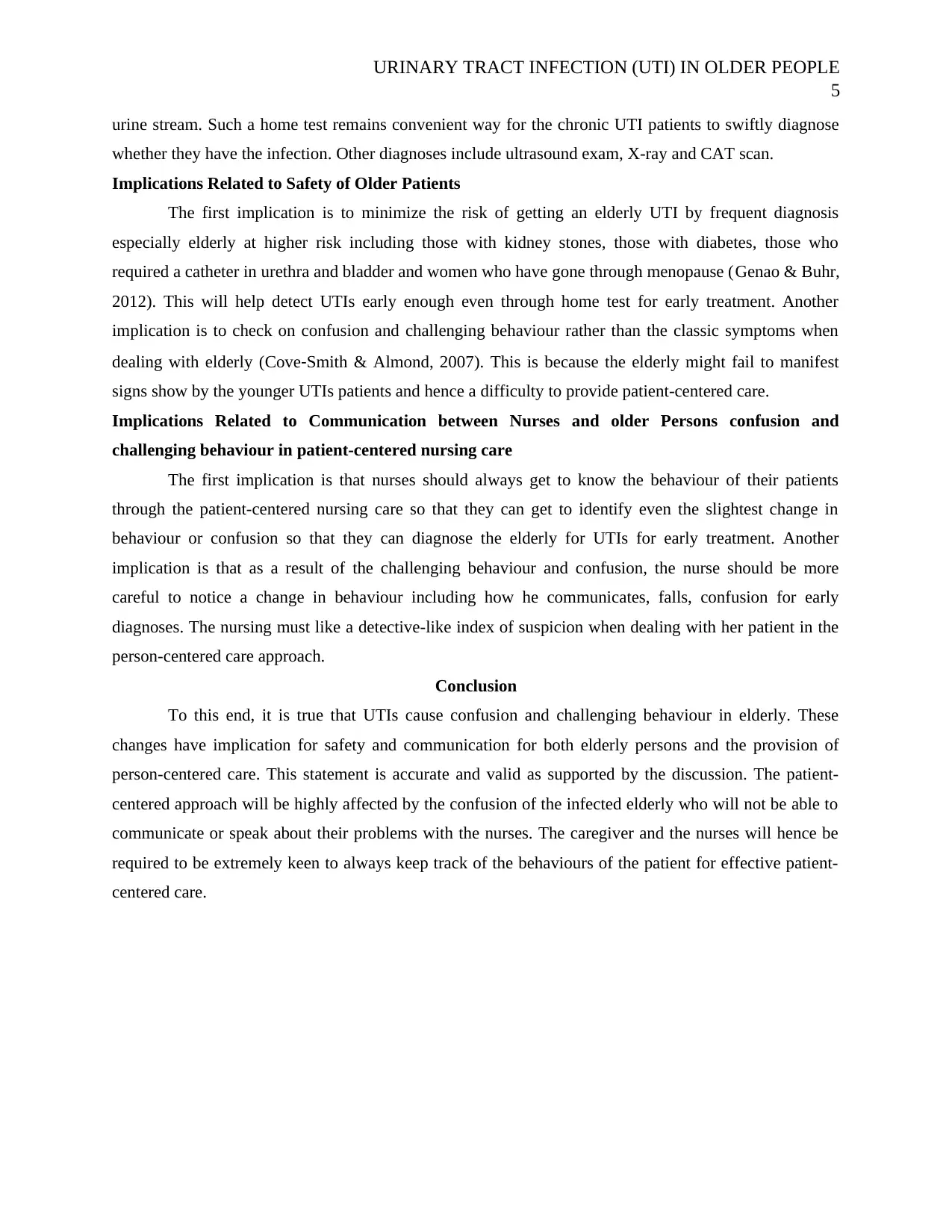
URINARY TRACT INFECTION (UTI) IN OLDER PEOPLE
5
urine stream. Such a home test remains convenient way for the chronic UTI patients to swiftly diagnose
whether they have the infection. Other diagnoses include ultrasound exam, X-ray and CAT scan.
Implications Related to Safety of Older Patients
The first implication is to minimize the risk of getting an elderly UTI by frequent diagnosis
especially elderly at higher risk including those with kidney stones, those with diabetes, those who
required a catheter in urethra and bladder and women who have gone through menopause (Genao & Buhr,
2012). This will help detect UTIs early enough even through home test for early treatment. Another
implication is to check on confusion and challenging behaviour rather than the classic symptoms when
dealing with elderly (Cove‐Smith & Almond, 2007). This is because the elderly might fail to manifest
signs show by the younger UTIs patients and hence a difficulty to provide patient-centered care.
Implications Related to Communication between Nurses and older Persons confusion and
challenging behaviour in patient-centered nursing care
The first implication is that nurses should always get to know the behaviour of their patients
through the patient-centered nursing care so that they can get to identify even the slightest change in
behaviour or confusion so that they can diagnose the elderly for UTIs for early treatment. Another
implication is that as a result of the challenging behaviour and confusion, the nurse should be more
careful to notice a change in behaviour including how he communicates, falls, confusion for early
diagnoses. The nursing must like a detective-like index of suspicion when dealing with her patient in the
person-centered care approach.
Conclusion
To this end, it is true that UTIs cause confusion and challenging behaviour in elderly. These
changes have implication for safety and communication for both elderly persons and the provision of
person-centered care. This statement is accurate and valid as supported by the discussion. The patient-
centered approach will be highly affected by the confusion of the infected elderly who will not be able to
communicate or speak about their problems with the nurses. The caregiver and the nurses will hence be
required to be extremely keen to always keep track of the behaviours of the patient for effective patient-
centered care.
5
urine stream. Such a home test remains convenient way for the chronic UTI patients to swiftly diagnose
whether they have the infection. Other diagnoses include ultrasound exam, X-ray and CAT scan.
Implications Related to Safety of Older Patients
The first implication is to minimize the risk of getting an elderly UTI by frequent diagnosis
especially elderly at higher risk including those with kidney stones, those with diabetes, those who
required a catheter in urethra and bladder and women who have gone through menopause (Genao & Buhr,
2012). This will help detect UTIs early enough even through home test for early treatment. Another
implication is to check on confusion and challenging behaviour rather than the classic symptoms when
dealing with elderly (Cove‐Smith & Almond, 2007). This is because the elderly might fail to manifest
signs show by the younger UTIs patients and hence a difficulty to provide patient-centered care.
Implications Related to Communication between Nurses and older Persons confusion and
challenging behaviour in patient-centered nursing care
The first implication is that nurses should always get to know the behaviour of their patients
through the patient-centered nursing care so that they can get to identify even the slightest change in
behaviour or confusion so that they can diagnose the elderly for UTIs for early treatment. Another
implication is that as a result of the challenging behaviour and confusion, the nurse should be more
careful to notice a change in behaviour including how he communicates, falls, confusion for early
diagnoses. The nursing must like a detective-like index of suspicion when dealing with her patient in the
person-centered care approach.
Conclusion
To this end, it is true that UTIs cause confusion and challenging behaviour in elderly. These
changes have implication for safety and communication for both elderly persons and the provision of
person-centered care. This statement is accurate and valid as supported by the discussion. The patient-
centered approach will be highly affected by the confusion of the infected elderly who will not be able to
communicate or speak about their problems with the nurses. The caregiver and the nurses will hence be
required to be extremely keen to always keep track of the behaviours of the patient for effective patient-
centered care.
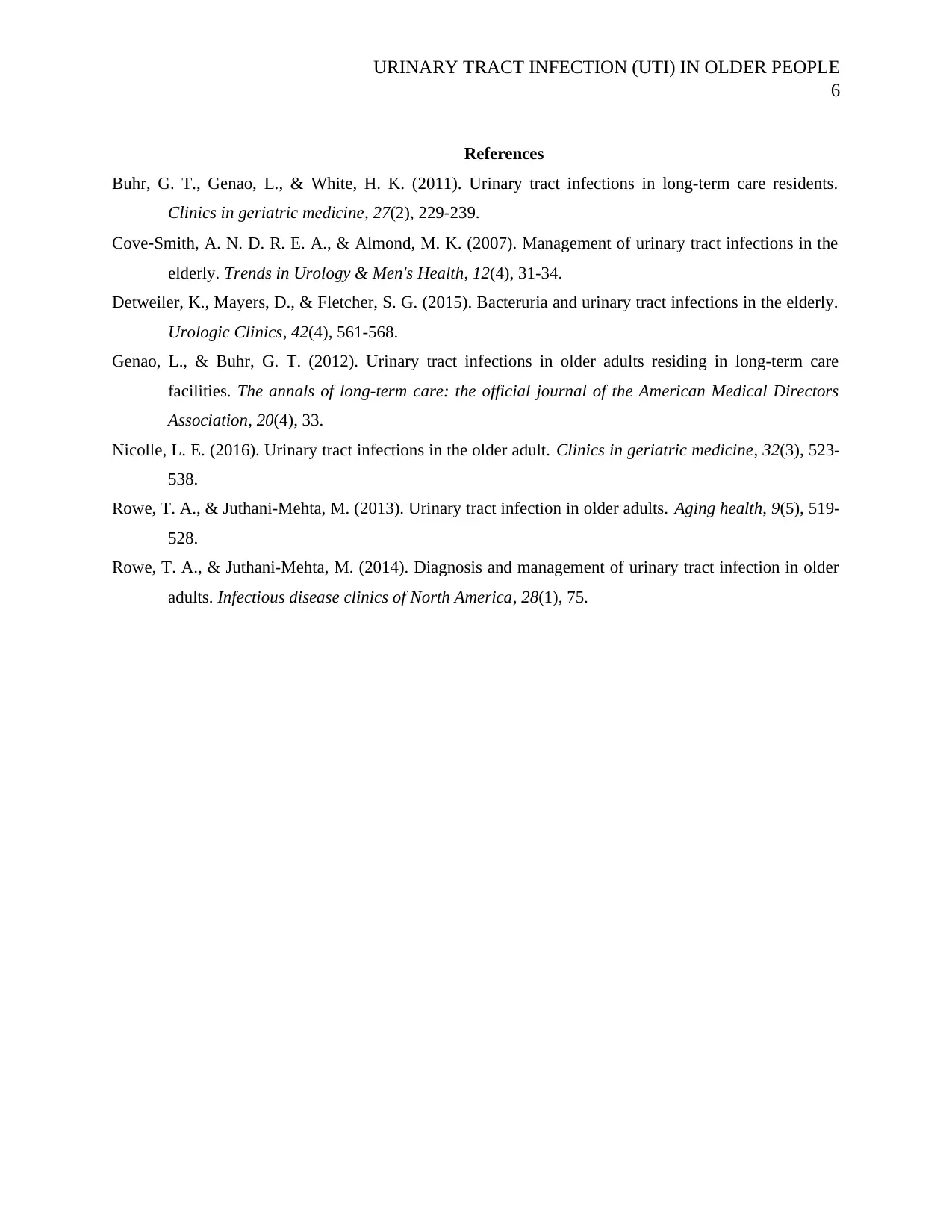
URINARY TRACT INFECTION (UTI) IN OLDER PEOPLE
6
References
Buhr, G. T., Genao, L., & White, H. K. (2011). Urinary tract infections in long-term care residents.
Clinics in geriatric medicine, 27(2), 229-239.
Cove‐Smith, A. N. D. R. E. A., & Almond, M. K. (2007). Management of urinary tract infections in the
elderly. Trends in Urology & Men's Health, 12(4), 31-34.
Detweiler, K., Mayers, D., & Fletcher, S. G. (2015). Bacteruria and urinary tract infections in the elderly.
Urologic Clinics, 42(4), 561-568.
Genao, L., & Buhr, G. T. (2012). Urinary tract infections in older adults residing in long-term care
facilities. The annals of long-term care: the official journal of the American Medical Directors
Association, 20(4), 33.
Nicolle, L. E. (2016). Urinary tract infections in the older adult. Clinics in geriatric medicine, 32(3), 523-
538.
Rowe, T. A., & Juthani-Mehta, M. (2013). Urinary tract infection in older adults. Aging health, 9(5), 519-
528.
Rowe, T. A., & Juthani-Mehta, M. (2014). Diagnosis and management of urinary tract infection in older
adults. Infectious disease clinics of North America, 28(1), 75.
6
References
Buhr, G. T., Genao, L., & White, H. K. (2011). Urinary tract infections in long-term care residents.
Clinics in geriatric medicine, 27(2), 229-239.
Cove‐Smith, A. N. D. R. E. A., & Almond, M. K. (2007). Management of urinary tract infections in the
elderly. Trends in Urology & Men's Health, 12(4), 31-34.
Detweiler, K., Mayers, D., & Fletcher, S. G. (2015). Bacteruria and urinary tract infections in the elderly.
Urologic Clinics, 42(4), 561-568.
Genao, L., & Buhr, G. T. (2012). Urinary tract infections in older adults residing in long-term care
facilities. The annals of long-term care: the official journal of the American Medical Directors
Association, 20(4), 33.
Nicolle, L. E. (2016). Urinary tract infections in the older adult. Clinics in geriatric medicine, 32(3), 523-
538.
Rowe, T. A., & Juthani-Mehta, M. (2013). Urinary tract infection in older adults. Aging health, 9(5), 519-
528.
Rowe, T. A., & Juthani-Mehta, M. (2014). Diagnosis and management of urinary tract infection in older
adults. Infectious disease clinics of North America, 28(1), 75.
⊘ This is a preview!⊘
Do you want full access?
Subscribe today to unlock all pages.

Trusted by 1+ million students worldwide
1 out of 6
Related Documents
Your All-in-One AI-Powered Toolkit for Academic Success.
+13062052269
info@desklib.com
Available 24*7 on WhatsApp / Email
![[object Object]](/_next/static/media/star-bottom.7253800d.svg)
Unlock your academic potential
Copyright © 2020–2025 A2Z Services. All Rights Reserved. Developed and managed by ZUCOL.





